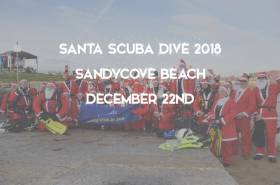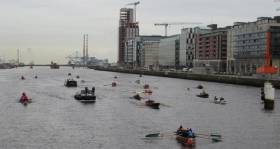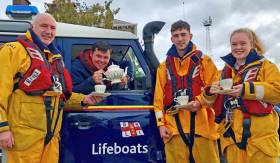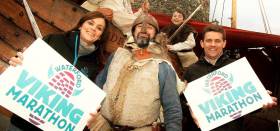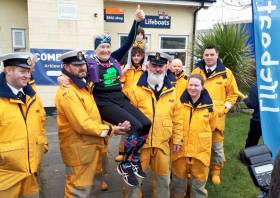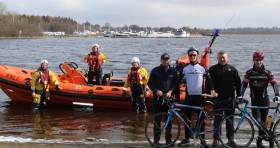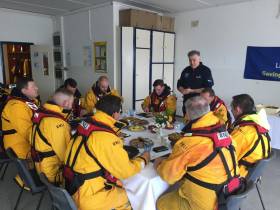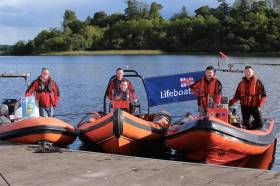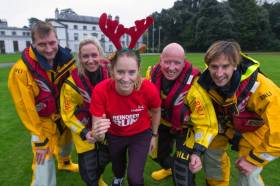Displaying items by tag: Fundraising
Sandycove Beach Ho-Ho-Hosting Santa Scuba Dive This Weekend To Raise Funds For Lifeboat Charity
This Saturday morning (22 December) 100 Scuba divers dressed in Santa suits will brave the elements and dive into the sea water off Sandycove Beach to raise money for the RNLI.
The annual Santa Scuba Dive has raised over €8,000 since 2014 when it was started by Karen Kenny of the Dublin University Sub-Aqua Club.
The unique Christmas event begins at 11am this Saturday 22 December at Sandycove Beach in Dun Laoghaire, Co Dublin — and spectators will also see the local D-class lifeboat, Howth Coast Guard RIB and a flyby from the Dublin-based coastguard helicopter, weather and operations permitting.
For more see the event page on Facebook and the fundraising page on JustGiving.
Mammoth Eight-Hour Rowing Challenge On River Liffey Will Raise Funds For Charities
All In A Row 2018 comes to the River Liffey this Saturday 1 December, challenging teams rowing 40 skiffs, kayaks, canoes and currachs to exceed a 1,000km target in eight hours.
The organisers are hoping to beat last year’s target during the event from St Patrick’s Rowing Club at the Tom Clarke Bridge (formerly the East-Link Bridge) and finishing at the Ha’penny Bridge.
While showcasing the River Liffey as one of Dublin’s best amenities, the challenge also aims to raise funds for water-related charities, namely the RNLI and the Irish Underwater Search and Recovery Unit.
The event will start at 8am this Saturday and at noon all boats will gather in front of the Sean O’Casey footbridge. A wreath-laying ceremony, attended by the Lord Mayor of Dublin Nial Ring, will also take place to commemorate all those who have lost their lives through drowning.
The event remembers particularly the crew of the currach rowed and sailed from the Liffey to Santiago de Compostela and who later lost a valued crew member in Danny Sheehy.
The RNLI will have an Atlantic 85 inshore lifeboat on display for people to view during the day, berthed alongside the Jeanie Johnston replica famine ship.
The event is also being used as an opportunity to engage with inner city Dublin schools whose pupils have been invited to the Dublin Docklands offices to learn about water safety through the RNLI’s Respect the Water campaign, and how they can volunteer in their communities to help save lives at sea. The city’s Sea Scouts will also be participating in the event.
Many Dublin rowing clubs have their home on the River Liffey and are a regular sight on the water. At the port end of the river is St Patrick’s Rowing Club, Stella Maris Rowing Club, East Wall Water Sports Group and Poolbeg Yacht and Boat Club.
Ringsend Basin is home to the Plurabelle Paddlers (Dragon boats) and the Dublin Viking Dragon boat club. At the other end of the city, beyond Heuston Station, there are many river rowing clubs and kayaking clubs, including Phoenix Rowing Club.
This Saturday the many boating clubs of the Liffey will be joined by rowing clubs from other parts of Ireland.
“Everyone knows the River Liffey but most people don’t know how far it stretches and how many rowing groups use it regularly,” organisers said.
“There is a vibrant boating community on the River Liffey and these clubs regard it as the living artery of the city and one of Dublin’s great and undervalued amenities.
“After the beautiful summer we’ve had, we know that people are drawn to the water, whether on the coast or inland to enjoy different water sports.
“The Liffey is an undervalued and underused resource that is right under people’s noses and we want to encourage them to use it and to use it safely. From school children right up to seasoned rowers, this is a great opportunity to draw people down to the Liffey and learn about water safety and the fun activities they can do on the water all year round.”
Competitors are asked to raise sponsorship for the event, and for those not competing and supporters, there is a GoFundMe page for donations.
Larne Lifeboat Crew To Open Their Doors For Macmillan Charity Coffee Morning
#RNLI - Larne’s volunteer RNLI crew are throwing open the doors of the lifeboat station as they host a coffee morning to raise funds for Macmillan, the cancer support charity, from 10.30am to 2pm on Saturday 29 September.
The crew are already planning a ‘bake off’ to entice the public along and to dig deep for Macmillan.
There will also be tours of the station, demonstrations of its vital lifesaving kit and talks to give an insight into lifeboat launches in and around Larne.
Eleganze Hair & Beauty, Marty’s Catering, Curran Court Hotel and Allan Dorman & Son are among the local businesses that have already shown their support with raffle prizes for the day.
“This will be a fundraiser with a difference for us here,” said lifeboat mechanic Derek Rea. “As a charity we are thankful to the people of Larne for supporting the lifeboat but we also want to help others and raise funds for this worthy cause.
“There is hardly a person whose life has not been touched by cancer, either through battling it themselves or seeing someone they care about suffering with it. Support for cancer sufferers and research into treatment is ongoing and the Macmillan coffee morning is a great way to raise awareness and funds for this work.”
The lifeboat station is situated at 11 Olderfleet Road in Larne and people wishing to learn more about the Macmillan coffee morning fundraisers can visit macmillan.org.uk.
Waterford Viking Marathon To Raise Funds For RNLI
#RNLI - Saturday 30 June has been confirmed as the date for the seventh annual WLRfm Waterford Viking Marathon to raise funds for the RNLI.
The most exciting running event in Waterford, the Viking Marathon following a spectacular route that takes in Waterford City’s Viking Triangle.
Runners will cross both Rice Bridge and the N25 suspension bridge and running along the Waterford Greenway before returning to the state-of-the-art WIT Arena at Carriganore.
Runners can also choose from the full, half or quarter marathon and help raise funds for the RNLI lifeboats, the nominated charity for this year’s event.
Register now on www.waterfordvikingmarathon.com.
The news comes after ‘Lap of the Map’ runner Mary Hickey joined the RNLI to launch its own annual Mayday fundraiser taking place next month, as previously reported on Afloat.ie.
Marathon Woman Completes ‘Lap Of The Map’ For RNLI
#RNLI - Three-and-a-half months after setting out from her Arklow home, 65-year-old marathon runner Mary Nolan Hickey has completed her ‘lap of the map’ visiting RNLI lifeboat stations around the Irish coast, as TheJournal.ie reports.
Hickey received a hero’s welcome at Arklow lifeboat station yesterday (Saturday 14 April) at the end of her fundraising challenge, for which she inspired donations amounting to more than €36,000 for the lifesaving charity.
Hickey covered over 1,507 miles - the equivalent of 57 marathons - across 18 counties since she began on 1 January, deliberately choosing to run anti-clockwise in the winter months, as a nod to the tough conditions RNLI crews often face on the water.
Heads up! Mary is on Ireland AM this morning just after 10am! pic.twitter.com/DSovOurml5
— Mary Hickey (@RNLILapoftheMap) April 15, 2018
“Once I started, there was no other thought in my mind other than ‘I will get this done.’ I could think of no better organisation to do this for,” Hickey told TheJournal.ie, which has more on her story HERE.
Fifth ‘Lap Of Lough Ree’ Launched To Raise Funds For Local RNLI
#RNLI - Lough Ree RNLI has launched their fifth Lap of Lough Ree, which will take place this year on Sunday 22 April raising funds for the lifeboat service in Athlone.
The 85km cycle will go anti-clockwise around Lough Ree, starting and finishing at The Bounty at Buccaneers Rugby Club, with a pit-stop in Lanesborough at the north of Lough Ree.
Speaking at the launch yesterday (Monday 12 March), Lough Ree RNLI volunteer lifeboat press officer Sarah Bradbury said: “We are delighted with the support that the cycle has received each year and that it’s becoming a favourite in the cycling calendar.
“This is a relatively relaxed route for cyclists to ease themselves back into the saddle while taking in the stunning views of Lough Ree.
“Those who participate in the cycle do so knowing they are raising vital funds for Lough Ree RNLI and we would like to thank them in advance for that.”
Bradbury said funds raised will maintain and equip our inshore lifeboat and will allow the volunteer crew to continue to train and develop their lifesaving skills.
Registration for the event will start at 9am the day in The Bounty. The entry fee is €20. For more information visit the Lough Ree RNLI Facebook page or email [email protected].
#RNLI - Derry Clarke, owner and chef at the renowned L’Ecrivain restaurant, turned Valentia Lifeboat Station in Kerry into one of the country’s top dining sports on Friday (29 September) as he treated the volunteer lifeboat crew to a delicious Fish Supper to promote the RNLI’s latest fundraising initiative.
Clarke, who is also star of RTE’s Lords and Ladles, is supporting the RNLI’s Fish Supper campaign for 2017 from 13-15 October — and is calling on people across Ireland to sink their teeth into a delicious fish dish to raise vital funds for the lifesaving charity.
The menu for the lifeboat crew comprised a number of mouth-watering seafood dishes including cured salmon with cucumber, apple and dill; seafood chowder; Flaggy Shore oysters and Lambay Island scallops with cauliflower and raisins.
Local hotel and restaurant The Royal also got involved when chef Ryan Walsh added a surprise extra course of fish gratin.
Speaking while cooking al fresco at the lifeboat station, Clarke said: “It is an absolute pleasure to cook for the Valentia lifeboat crew. I love cooking for the RNLI, and seafood dishes are always a crowd pleaser.
“I do an annual BBQ for the RNLI with my wife Sallyanne on Sherkin Island and at Courtown in Wexford, so it’s about time I got out to the West Coast. The only issue is that you never know if you have enough food as lifeboat crew are always hungry.”
Clarke also urged anyone who hasn’t tried cooking with fish to give it a try and impress your friends and family while raising vital funds for the RNLI’s brave lifeboat crews.
“We are lucky enough to live on an island with a beautiful array of fish on our doorstep. It’s a wonderful idea for a fundraiser.”
The occasion was captured by photographer Jack Lowe, who is travelling around the UK and Ireland photographing RNLI lifeboat volunteers through a Victorian process that captures the stunning images on glass. Jack’s visit to Valentia RNLI marked his 100th lifeboat station.
Valentia RNLI coxswain Richard Quigley added: “Our pagers can go off at any time and many a meal has been interrupted for a lifeboat launch. Holding a fish supper is a great way for people to support us. They can sign up for a free fundraising pack and then enjoy hosting a fun evening with friends and family.
“If like us, you’re not Derry Clarke in the kitchen, then you can always serve up something simple like a fish finger sandwich or fish and chips. We really don’t mind.”
To receive a free Fish Supper fundraising pack, and to see some mouth-watering recipe inspiration, visit RNLI.org/FishSupper.
RNLI lifeboat crews across Ireland launched 1,136 times in 2016, rescuing 1,649 people. Kerry lifeboat stations launched 38 times and rescued 47 people in that same period, spending a total of 393 hours at sea on service.
Last year, chef Clodagh McKenna visited Howth RNLI to support the charity, which relies on donations from the public to continue its lifesaving service.
Round Ireland RIB Run For Worthy Causes This Month
#RIBs - A team of intrepid boaters from the Lakelands are prepping for a round-Ireland RIB run this month in aid of three worthy causes.
Joe Gavin and Kevin McCaffrey will be joined by friends Dermot McGuire, Damien Mundy and Stephen Leddy as they set out on two RIBs from Greystones on 20 June heading clockwise around Ireland, raising funds for the RNLI and two Irish charities, Time For Tilara and Chloe Standing Tall.
The RIB runners have scheduled stops at Rosslare, Crosshaven, Sherkin Island, Dingle, Lahinch, Clifden, Belmullet, Burtonport, Downings, Portrush and Donaghadee before their return to Greystones on 1 July.
All donations received will go direct to the three charities, and the team would be pleased to receive any support along the way — even by joining the run for a spell in your own vessel.
The Facebook page has more on the fundraising challenge HERE.
Cliona Hagan To Play Bundoran RNLI Annual Dance
#RNLI - Country singer and RTÉ’s Best Newcomer 2016 Cliona Hagan is set to perform at the annual Bundoran RNLI dance, which takes place on Friday 27 January at the Great Northern Hotel in Bundoran.
The event, now in its 42nd year, is the flagship fundraising event for the charity that saves lives at sea and is a hugely anticipated staple in the local calendar.
“This is a huge fundraising night for us and we are forever grateful to our local supporters who come out in such great numbers each year,” said event director Cormac McGurren.
“I’d also like to acknowledge the sponsors of our raffle prizes who give so generously each January.
“We have decided to try out a less formal buffet-style this year and we hope that everyone attending will enjoy a good night of music and food.”
Speaking at the launch, Cliona Hagan said: “I’m really looking forward to playing at this prestigious event and supporting this great charity – I’ve heard such great things about the night and it promises to be a good one!”
Tickets are on sale locally from all lifeboat crew members, BMG Hardware Bundoran, McNern Barbers Ballyshannon, Temptations Beauty Studio Ballyshannon, O'Neill's Next Door Off Licence Ballyshannon and Bundoran Tourist Office.
All funds raised on the night remain at the local station in Bundoran and go towards crew training and maintenance of the boathouse and lifeboat itself.
#RNLI - The RNLI’s festive Reindeer Runs are back in three locations in Cork and Dublin.
And the charity that saves lives at sea is encouraging families to come out, get involved and get moving for a great cause.
Renowned athlete and author Derval O’Rourke is the Reindeer Run ambassador and put her support behind the event as she joined lifeboat crew and their families at Fota Park House and Gardens in Cork for the official launch recently.
Speaking at the event, she said: “It is a real privilege to be back as the ambassador for the Reindeer Run which is a fantastic fundraising event for the RNLI.
“The RNLI is a charity close to my heart, as my husband [and fellow Olympian Peter O'Leary] is heavily involved in sailing and I find it incredibly reassuring that the RNLI provides such a great service.
“This event combines our families’ two big passions running and the water. With all of our lives becoming increasing sedentary an event such as the Reindeer Run is a fantastic opportunity to get out and get moving in three stunning venues around Ireland.
“I am really excited to be there on the day, and to be able to give out my ‘fit foodie’ goodie bags to the deserving winners.”
Crosshaven RNLI lifeboat helm Vince Fleming was joined by his two daughters Saoirse and Zarah at the launch and spoke about why the Reindeer Runs are so important.
“As a charity we rely on the goodwill of the public and it is great to be able to hold events like these that are family focused, great fun and give people a an enjoyable day out for a good cause,” he said.
“The funds we raise through the Reindeer Runs support the RNLI in Ireland, providing vital training, equipment and kit for the volunteer lifeboat crew.
“The RNLI is not just about the lifeboat volunteers and the wider team behind the launches and fundraising. There are also the countless families behind every callout for every person brought home.”
The RNLI Reindeer Runs are being held on Sunday 20 November at Liss Ard Estate, Skibbereen; Sunday 27 November at Fota Park House and Gardens, Cork; and Sunday 4 December in Marlay Park, Dublin.
The event consists of a 5km and 10km run or walk and a 1km Santa Saunter for children. Entry fees for the longer distances are €20/€22 with the Santa Saunter €12.50 with accompanying adults free. All participants get a festive RNLI Reindeer Run t-shirt and a pair of novelty antlers to wear.
For more information and to register for the event, visit www.rnli.org/reindeerrun


























